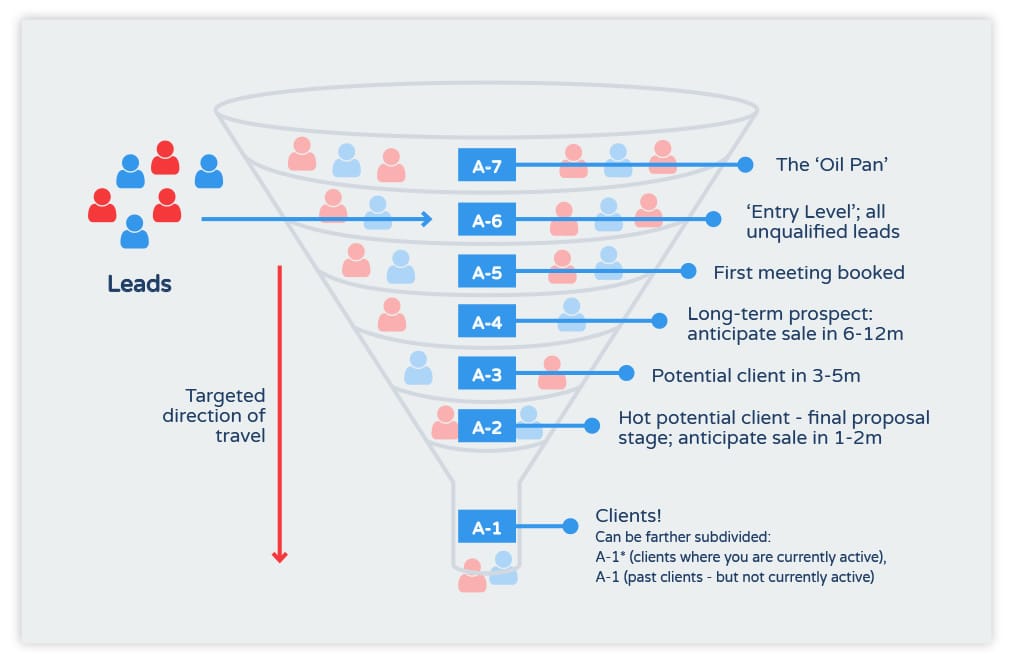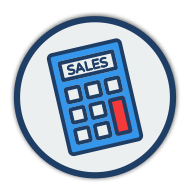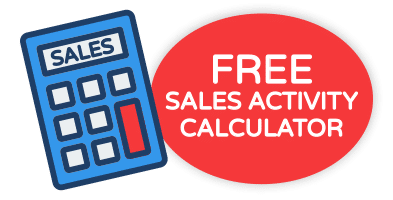Social creatures - An authentic numbers game - Build a categorization model - Daily forward momentum - What more can I do to nudge this along? - It is all about the numbers - Key ratios - Sales Activity Today, Revenue Tomorrow - Collective language - The seven-to-one rule-of-thumb
At the heart of the professional service sale is a relationship or set of relationships. Of course, there are instances when you might be bidding for a piece of work through a sterile, de-personalised tender exercise (say, for a governmental contract). Even then though, it is likely that relationships become a (maybe subliminal) feature of the evaluation despite all efforts to make it clinically objective. Humans are inherently social creatures and services businesses cannot escape this reality. Conversely, they need to embrace it. In short, selling is primarily a human, or social, endeavour and you need to be fixated on your ability to build relationships and the trust required for a buyer to buy. The key device you need to manage this process is your sales pipeline.
A word of caution up-front. Whilst I will emphasise the numbers (or ratio) game inherent in this capability, I am not seeking to dehumanise the whole process. Or, at worst, to encourage some kind of false charade of geniality. Rather, I must reinforce that the best sales person is someone who feels passionately that their service is of value to their clients and genuinely enjoys the human interaction involved in matching need-with-solution. You can, and should, instil a numbers discipline with ethics and authenticity. The two aspects are completely mutually compatible.
Building your first sales pipeline
So, how do you best track people through the pipeline? As per usual, there is no one right answer; so, what I share with you now is just a model variant that works. The important thing is that you adjust it as required in order to settle on an approach that is cemented within your firm. The critical success factor lies more in the embedment of a collectively understood method/language within your firm and less in the fine specifics of the process you design.
Fundamentally, I am recommending that you build a holistic view of the people pipeline. It starts with a Lead; this can be a very tepid or tenuous connection – maybe just someone you have seen listed as being in a typical buying role but you haven’t met. Next, we have a Contact; this is someone that you have had even the most basic contact with (for example, you have established that they are, indeed, in a relevant position or you may have had cursory conversation). As such, in my model, the Lead-to-Contact conversion can happen very quickly and effortlessly. At the end of the pipe you have Clients, relationships that have put their signature to a sold piece of work. It is, therefore, the Contact-to-Client conversion we need to really focus upon.
Your fixation here should be one of how quickly you can make this happen. To manage this – especially so when you start to perform this at the requisite volume – you need to know who is at what stage in this chronological journey such that you are constantly and proactively engaged in moving your relationships, along your sales pipeline, one stage closer to the sale. Allow me to illustrate with the following categorization model:

Figure: Illustrative contact categorization model
Hopefully, the schematic above is self-explanatory; it shows a logical time-based progression along the lines I used at Moorhouse. The A-7 (‘Oil Pan’ ) warrants some explanation. This was just the level to which we assigned any contact that essentially was a dead end but whose information we didn’t want to completely lose.
Once you have designed a categorization system for your sales pipeline and set up a firm-wide contact pipeline that uses this reference, you will be able to see how many sit at each level (for yourself and across the wider firm). This, in turn, enables a step change in the management disciplines you can bring to bear on this activity.
At a personal level, you can access a contact record through this view. Each day – and this should be a daily activity – you seek to generate forward momentum. You will want to move a few from the A-6 entry point to the status of a booked meeting (maybe via an introductory call). You will certainly want to keep a close eye on the A-2s asking yourself: what more can I do to nudge this to the final sale moment? And, of course, you are constantly seeking to progress the A-4s down the pipe with catch-up conversations (Is there anything more you need from us to support buying decision?; invites to firm events to keep dialogue active etc).
At a collective capability level, this is all about numbers and, more importantly, key ratios. After a while we knew the level of meetings we needed to schedule each month (that is the number of contacts we moved from A-6 to A-5) for us to meet our forward revenue plans in, say, six months’ time. With historical data, this became almost scientific; that is a dip in revenue was almost wholly explainable by the dip in this essential leading activity six months prior. So, capturing and managing this data across the firm becomes invaluable to the leaders of the business.
Clearly, all of this is best enabled by a shared tool. Apart from the common pipeline view, this reduces the risk of duplicative or uncoordinated sales activity also. Further, once you approach the levels of activity required to be successful here, it is impossible to remember where you are with each conversation without some form of electronic record. Even if your IT budgets are constrained initially, there is no excuse not to implement some form of system immediately; this really can be done on a shoestring.
In the earliest efforts at Moorhouse, we simply used Microsoft Outlook contacts to manage our sales pipeline via a shared folder. The key was the category data field that would be applied to every contact within this folder. Nowadays, however, there are many tremendous cloud-based applications that bring a rich additional feature set to this process – not least the management of related tasks (calls, meetings etc) and the reporting of key activity/ratio metrics.
After a detailed system evaluation exercise, we eventually moved to SalesForce and found this to be an excellent enabler. It moved us another significant step up the selling maturity curve. With Method Grid, we are trialing Pipedrive – a much simpler, cheaper solution. Regardless of which solution is right for you, I implore you to introduce and embed such a system from an early stage also.
ACTIVITY (AND FREE TOOL!)
If you have no comparable process in place, this is far too important to leave a moment longer. Take some time to develop your categorisation process (or maybe stick to the one I have referenced). Sort your contacts now into this pipeline view. I want you to also think about the type of ratios you need to meet your revenue targets. To do so, you need to answer the following questions:
What is the average contract value ($) of work you anticipate selling?
How many of these average units do you need to sale to meet plan?
How many proposals do you envisage producing to win a piece of work (win ratio)?
How many prospect meetings do you envisage having to generate for each single request for proposal (meeting-to-proposal ratio)?
How many calls do you envisage needing to make for each booked meeting (call-to-meeting ratio)?
Through this structured working-back analysis you then arrive at a hypothesis as to the level of up-front, leading sales activity required to generate your downstream success.
Are you anywhere near it?
Signup below for your free sales activity ratio calculator!
Please send me
My free sales activity ratio calculator

TOP TIPS
Regardless of your contact management software, you should ensure that the contact record contains a sales categorisation label and the primary contact owner within your firm. This point is really key. You don’t need to be so rigid as to enforce one-to-one relationships; clearly the world is not that simple. But, as this activity starts to include many contacts, it is important you remain coordinated and the best way of doing this is by having clear, primary owners allocated to each contact.
Another aspect we found useful to introduce as a collective language point was a common set of abbreviations used when contact records were being updated. For example: ‘120522 LVMM’ = Left voicemail message on their mobile on the 22 May 2012.
Clearly, the more information you collect on conversations the better (especially so when contacts/relationships are transferred) and any such established code can speed up this capture exercise.
As described in the Activity above, it is essential that you get familiar with the sales conversion ratios on which your revenue plan is based. At least have a hypothesis to test and a target to aim for and improve upon. If you have no idea because you lack any experiential data on which to base this, then you might want to start with the 7-to-1 rule of thumb that many firms cite. That is, it takes seven (well-placed) calls to generate one meeting and seven meetings to generate one proposal request. Thereafter, you are in the realm of win ratios/targets which will typically lie anywhere between 10–50% dependent on the nature of your business sector and quality of your proposal/service!

 Project and Program Management
Project and Program Management  Project Governance Framework
Project Governance Framework  Benefits Management Framework
Benefits Management Framework 






